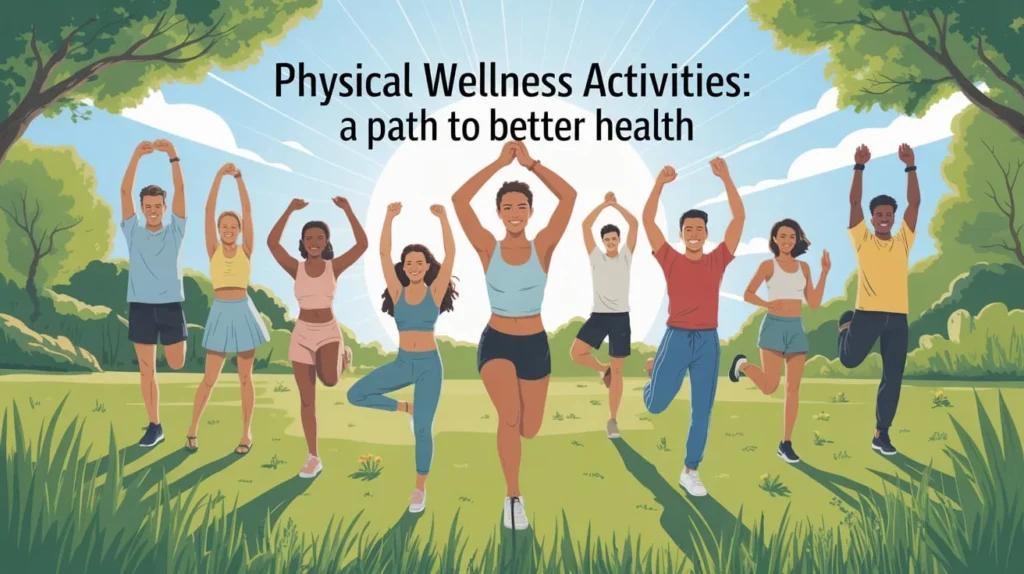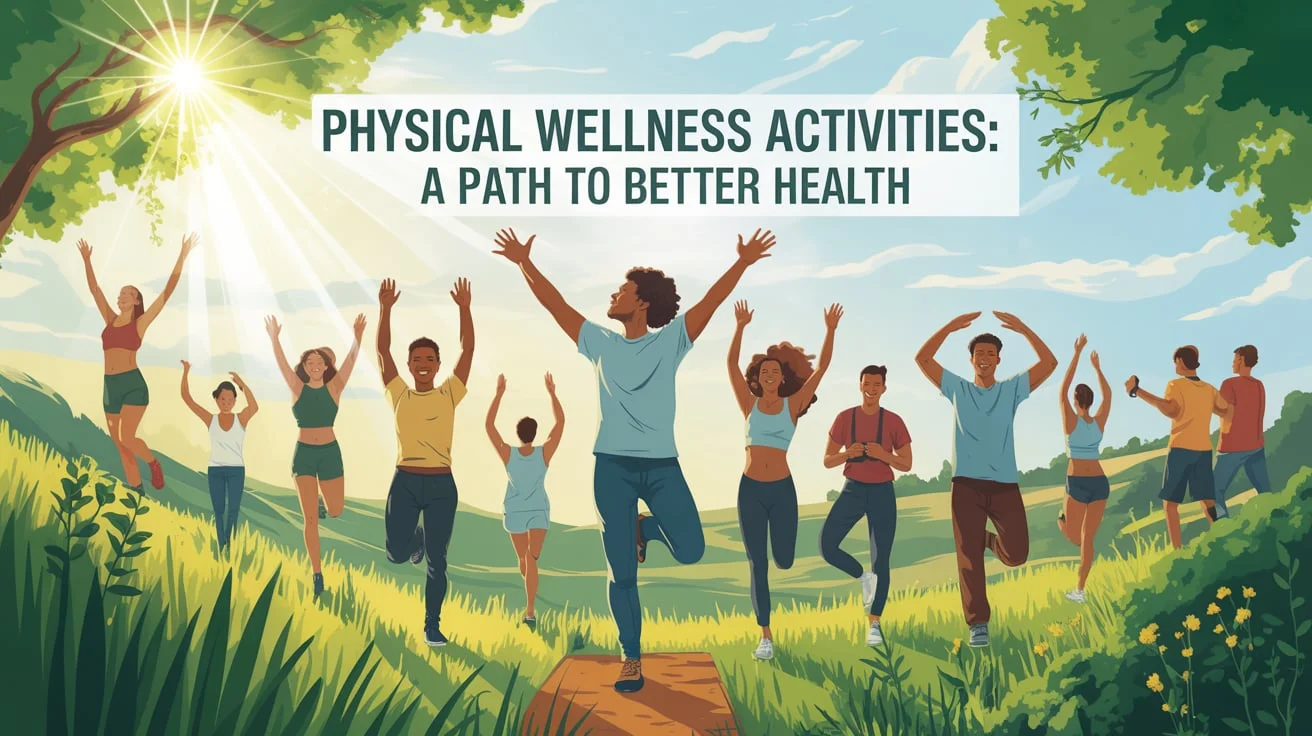Physical Wellness Activities: A Path to Better Health
In today’s fast-paced world, maintaining health can feel like a challenge, but it doesn’t have to be. Physical wellness activities provide a straightforward and effective way to enhance your body, mind, and energy levels without requiring extreme routines.
From a brisk morning walk to mindful stretching before bed, these activities promote strength, flexibility, and mental clarity.
By incorporating movement into your daily life, you’re not just burning calories; you’re boosting immunity, improving posture, and enhancing your mood.
In this guide, we’ll explore powerful, practical strategies to help you stay physically well, even with a busy schedule. Whether you’re a beginner or looking to refine your fitness routine, this article will give you the tools and confidence to move toward a healthier you.
1. Why Physical Wellness Activities Matter
Physical wellness activities go far beyond just staying fit; they’re essential for building a healthy, balanced life. Regular movement improves stamina, lowers stress, and helps you sleep better. Over time, these habits support long-term health and reduce the risk of lifestyle diseases.
Whether it’s walking, stretching, or a full workout, small daily actions can lead to significant changes. Staying consistent with your movement can help you feel younger, sharper, and more confident every day.
2. Core Categories of Activities
The foundation of any wellness routine lies in variety. When you incorporate various types of physical wellness activities, you target different parts of the body and support overall health. A well-balanced routine includes cardiovascular work, strength training, flexibility movements, and mind-body practices.
These categories not only improve your physical strength but also sharpen mental focus and help relieve stress. With time, you’ll notice better posture, improved endurance, and stronger muscles.
Strength activities:
- Cardiovascular exercises
Improve heart function and endurance through walking, running, cycling, or swimming. - Strength training
Builds muscle and boosts metabolism using weights, resistance bands, or body weight. - Flexibility and balance work
Enhances range of motion and reduces injury risk with yoga, dynamic stretching, or tai chi. - Mind‑body practices
Connect movement with mindfulness through Pilates, dance therapy, or breathing-focused exercises.
3. How to Start a Fitness Routine

Starting your wellness journey doesn’t need to be overwhelming or stressful. Begin with small, manageable steps that feel comfortable to your body. Focus on consistency rather than intensity to build sustainable habits.
Choose activities that bring you joy, like dancing, light jogging, or evening walks. Enjoyment helps you stay committed and makes exercise feel less like a chore. If it feels good, you’re more likely to keep doing it.
Set a simple daily goal, such as 15 minutes of movement, and mark it on your calendar. Treat it like an appointment that’s important for your health. Over time, these small actions will lead to significant results.
4. Sample Weekly Plan
Creating a balanced workout schedule is the most effective way to build strength without overexerting your body. By rotating different types of physical wellness activities, you allow your muscles to rest, recover, and grow stronger. A well-rounded weekly plan includes cardio, strength training, flexibility exercises, and active recovery.
Your weekly routine doesn’t need to be complicated or intense. Even short and straightforward workouts can make a big difference when done consistently. The following sample plan provides your body with a variety of movement styles to achieve a comprehensive
| Day | Activity |
| Monday | 30-minute walk + light stretching |
| Tuesday | Strength training (push-ups, squats) |
| Wednesday | Yoga or Pilates |
| Thursday | Jogging or cycling |
| Friday | Resistance bands + planks |
| Saturday | Fun activity (dance, hiking) |
| Sunday | Active rest (foam rolling, walking) |
5. Tips for Effective Exercise
The quality of your workouts is more important than how hard you push. Focus on controlled, safe movements rather than rushing through reps. A proper warm-up helps your muscles and joints prepare for the activity ahead.
Pay attention to how your body feels during exercise. Take breaks when needed and never ignore pain or discomfort. Long-term progress comes from patience, not perfection.
Effective Tips:
- Warm up with light cardio before intense workouts.
- Breathe evenly and stay mindful of your form.
- Stretch gently after each session to promote recovery.
6. Overcoming Common Barriers
Starting or maintaining physical wellness activities isn’t always easy. Most people face hurdles such as time, motivation, or a lack of resources. But real progress begins when you recognize those challenges and respond with simple adjustments.
If time is tight, break your workouts into smaller chunks, such as two 10-minute sessions. Even slight movement, such as walking during phone calls, can make a significant difference. What matters is showing up consistently in a way that fits your life.
No gym? No problem. Your body weight, stairs at home, or a filled water bottle can be powerful tools for achieving your goals. Staying active doesn’t require fancy equipment, just creativity and a little determination.
7. Benefits Beyond the Body
Physical wellness not only reshapes your body but also rewires your brain for improved focus and clarity. Regular movement has been proven to enhance cognitive function and memory. As a result, you become sharper, more alert, and mentally agile throughout your day.
Moreover, exercise plays a decisive role in supporting emotional balance. It reduces the effects of stress hormones and stimulates feel-good chemicals, such as endorphins. This natural mood boost can significantly ease anxiety and mild depression symptoms.
When your body is strong, your mind follows with increased confidence and resilience. You approach challenges with positivity and calmness. True wellness radiates from the inside out, affecting every part of your life.
8. Monitoring Your Progress
Tracking progress keeps you engaged and motivated. Seeing your improvements written down, whether it’s increased stamina or better posture, reminds you that your efforts are paying off. It also helps you set new goals and avoid getting stuck in a routine.
Visual reminders of progress, like habit trackers or fitness apps, can boost your confidence.
9. Adapting and Scaling Up
As your strength builds, your body needs new challenges. This doesn’t mean working out harder; it means working out smarter. Minor tweaks to your routine can help you avoid plateaus and prevent boredom.
Challenge yourself gradually and listen closely to how your body responds.
10. Staying Motivated Long-Term
Motivation is powerful, but it’s also temporary. When it fades, your routine can easily fall apart unless you have systems in place to support it. That’s where commitment, planning, and variety make a real difference.
To stay consistent, keep your workouts fresh and exciting. Changing your scenery, music, or workout partners can instantly boost energy. Even small tweaks prevent boredom and reignite your interest.
Simple Ways to Stay Motivated
- Set new goals every 4–6 weeks to track progress.
- Join a fitness group or online challenge.
- Rotate between different types of workouts on a weekly basis.
- Reward yourself after meeting milestones.
- Keep a visual tracker to celebrate consistency.
- Listen to upbeat playlists to fuel your mood.
- Remind yourself why you started journaling
- Get enough rest mental fatigue kills motivation.
- Take active rest days to recharge.
- Focus on how you feel, not just how you look
Conclusion: Your Path to Lasting Wellness
True wellness doesn’t come from trends or shortcuts; it comes from daily decisions. Whether you’re walking around the block or attending a fitness class, each step matters. Over time, these consistent physical wellness activities shape a life that feels balanced, energized, and empowered.
Start today with one small step. Your journey toward better health doesn’t require perfection, just action. Let movement become a part of who you are, and your body will reward you with strength, peace, and vitality.
Frequently Asked Questions:
1. What are some easy physical wellness activities for beginners?
Walking, stretching, light yoga, and bodyweight exercises, such as squats or wall push-ups, are perfect for getting started.
2. How much physical activity should I do each week?
Aim for at least 150 minutes of moderate-intensity activity per week; this can be achieved by doing 30 minutes a day, five days a week.
3. Can I stay healthy without going to the gym?
Absolutely. Home workouts, outdoor walks, or simple routines using resistance bands can keep you fit and active.
4. What’s the best time of day to exercise?
The best time is when you can stay consistent. Morning workouts boost energy, while evening ones can help relieve stress.
5. How soon can I expect to see results from physical healthy activities?
Many people feel better within two to three weeks. Visible changes, like strength or weight loss, typically appear in 4–8 weeks with regular effort.


